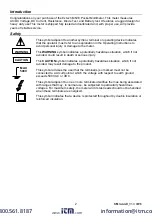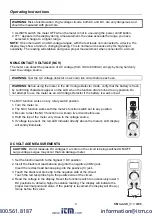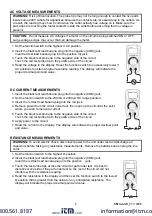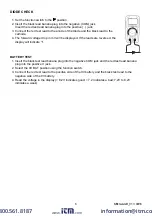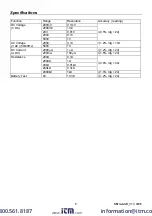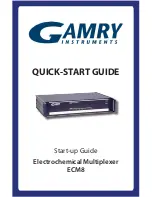
MN10-en-GB_V1.3 09/16
7
Maintenance
This MultiMeter is designed to provide years of dependable service, if the following care instructions
are performed:
1.
KEEP THE METER
DRY. If it gets wet, wipe it off.
1.
USE AND STORE THE METER IN NORMAL TEMPERATURES.
Temperature extremes can
shorten the life of the electronic parts and distort or melt plastic parts.
2.
HANDLE THE METER GENTLY AND CAREFULLY.
Dropping it can damage the electronic parts
or the case.
3.
KEEP THE METER CLEAN.
Wipe the case occasionally with a damp cloth. DO NOT use
chemicals, cleaning solvents, or detergents.
4.
USE ONLY FRESH BATTERIES OF THE RECOMMENDED SIZE AND TYPE.
Remove old or
weak batteries so they do not leak and damage the unit.
5.
IF THE METER IS TO BE STORED FOR A LONG PERIOD OF TIME
, the batteries should be
removed to prevent damage to the unit.
BATTERY REPLACEMENT
WARNING
: To avoid electric shock, disconnect the test leads from any source of voltage before
removing the back cover or the battery cover.
1.
Disconnect the test leads from the meter.
2.
Remove the Phillips head screw located on the back of the instrument and remove the battery
cover.
3.
Replace the 12V battery.
4.
Secure the fuse/battery compartment cover.
5.
Dispose of the old battery as required by local regulations.
The end user is legally bound (EU Battery ordinance) to return all used batteries, disposal
in the household garbage is prohibited! Bring used batteries / accumulators to collection
points in your community or wherever batteries / accumulators are sold!
Disposal: Follow the valid legal stipulations in respect of the disposal of the device at the
end of its lifecycle
WARNING:
To avoid electric shock, do not operate your meter until the battery cover is in place and
fastened securely.
FUSE REPLACEMENT
1.
Disconnect the test leads from the meter.
2.
Remove the 3 Phillips head screws securing the meter’s rear cover and lift the cover off.
3.
Gently remove the fuse and install the new fuse into the holder.
4.
Always use fuses of the proper size and value 0.2A/250V fast blow
5.
Secure the rear cover.
WARNING
: To avoid electric shock, do not operate your meter until the rear cover is in place and
fastened securely.
www.
.com
information@itm.com
1.800.561.8187


